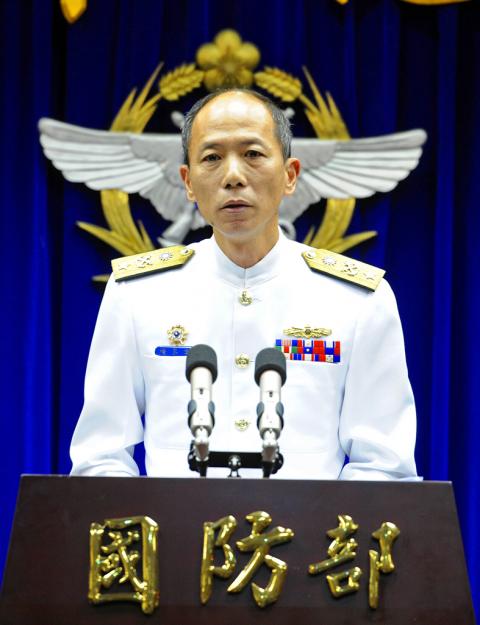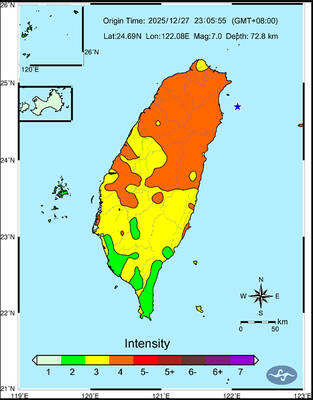The military is for the first time to incorporate cyberwarfare and civilian planes in its annual Han Kuang series of exercises later this month at various air bases and maritime areas.
The exercises will include drills centered on military personnel, equipment and aircraft to test joint combat capabilities of the air force, navy and army in case of an attack by China, Rear Admiral Mei Chia-shu (梅家樹) said.
As part of the exercise, the cyberwarfare drill is to test the military’s abilities to restore hobbled facilities, Mei said during a Ministry of National Defense press conference yesterday.

Photo: George Tsorng, Taipei Times
Live-fire drills will be held in waters off the eastern coast, south of Penghu, as well as in areas in Pingtung County, to test defensive capabilities, he said.
Exercises involving several civilian planes are to transport soldiers from Greater Kaohsiung to Penghu County to test readiness for wartime maneuvers, another military official said.
The Han Kuang exercises this year will last from Sept. 15 to Sept. 19 at designated sites, ministry spokesman Major General David Lo (羅紹和) said.
There will be drills to practice emergency takeoffs and landings for fighter jets on the Minsyong section of the Sun Yat-sen Freeway (Freeway No. 1), which passes through Chiayi County, said Major General Li Ting-sheng (李廷盛), director of the air force’s Combat Readiness Training Division.
Aircraft used in the drill this month will include F16-A/Bs, Mirage 2000-5s and Indigenous Defense Fighters (IDF), as well as the E-2K airborne early warning aircraft, a CH-47 helicopter, an OH-58D reconnaissance helicopter and two AH-1W Super Cobra attack helicopters, Li said.
The exercises this year are to simulate an attack from China that destroys Taiwan’s air force bases, leaving the military to rely on the freeway for emergency takeoffs and landings, he said.
It is also to test the military’s ability to conduct refueling and re-supply operations in times of war, Li added.
To conduct the drill, the section of the freeway between the Chiayi and Dalin exits will be closed for 11 hours beginning at midnight on Sept. 16.
Meanwhile, a new weapon, known as the “Wanjian missile” (萬劍彈), is reportedly ready for production after being developed for many years by the ministry.
Chinese Nationalist Party (KMT) Legislator Lin Yu-fang (林郁方) yesterday confirmed the news about the weapon, which is designed to destroy enemy runways.
Developed at a cost of about NT$3 billion (US$100 million), the Wanjian cruise missile system will go into production next year, after passing initial combat testing trials recently, Lin said.
The missile contains hundreds of cluster bomblets to maximize damage to runways, while it can also be used against other enemy targets, including harbors, military encampments, radar systems and missile launch installations.
“Our IDF jets have been configured to carry the Wanjian missiles and can reach targets within 300km. This has improved the air-to-land attack capability to greater than that of the F16-A/B jets and expanded the air force’s attack range for coastal military installations in China,” Lin said.
He added that 40 IDF jets were outfitted to carry Wanjian missiles by the end of last year, and eventually all the nation’s 127 IDF jets will be configured for such capability.
Additional reporting by CNA

A magnitude 7.0 earthquake struck off Yilan at 11:05pm yesterday, the Central Weather Administration (CWA) said. The epicenter was located at sea, about 32.3km east of Yilan County Hall, at a depth of 72.8km, CWA data showed There were no immediate reports of damage. The intensity of the quake, which gauges the actual effect of a seismic event, measured 4 in Yilan County area on Taiwan’s seven-tier intensity scale, the data showed. It measured 4 in other parts of eastern, northern and central Taiwan as well as Tainan, and 3 in Kaohsiung and Pingtung County, and 2 in Lienchiang and Penghu counties and 1

FOREIGN INTERFERENCE: Beijing would likely intensify public opinion warfare in next year’s local elections to prevent Lai from getting re-elected, the ‘Yomiuri Shimbun’ said Internal documents from a Chinese artificial intelligence (AI) company indicated that China has been using the technology to intervene in foreign elections, including propaganda targeting Taiwan’s local elections next year and presidential elections in 2028, a Japanese newspaper reported yesterday. The Institute of National Security of Vanderbilt University obtained nearly 400 pages of documents from GoLaxy, a company with ties to the Chinese government, and found evidence that it had apparently deployed sophisticated, AI-driven propaganda campaigns in Hong Kong and Taiwan to shape public opinion, the Yomiuri Shimbun reported. GoLaxy provides insights, situation analysis and public opinion-shaping technology by conducting network surveillance

‘POLITICAL GAME’: DPP lawmakers said the motion would not meet the legislative threshold needed, and accused the KMT and the TPP of trivializing the Constitution The Legislative Yuan yesterday approved a motion to initiate impeachment proceedings against President William Lai (賴清德), saying he had undermined Taiwan’s constitutional order and democracy. The motion was approved 61-50 by lawmakers from the main opposition Chinese Nationalist Party (KMT) and the smaller Taiwan People’s Party (TPP), who together hold a legislative majority. Under the motion, a roll call vote for impeachment would be held on May 19 next year, after various hearings are held and Lai is given the chance to defend himself. The move came after Lai on Monday last week did not promulgate an amendment passed by the legislature that

AFTERMATH: The Taipei City Government said it received 39 minor incident reports including gas leaks, water leaks and outages, and a damaged traffic signal A magnitude 7.0 earthquake struck off Taiwan’s northeastern coast late on Saturday, producing only two major aftershocks as of yesterday noon, the Central Weather Administration (CWA) said. The limited aftershocks contrast with last year’s major earthquake in Hualien County, as Saturday’s earthquake occurred at a greater depth in a subduction zone. Saturday’s earthquake struck at 11:05pm, with its hypocenter about 32.3km east of Yilan County Hall, at a depth of 72.8km. Shaking was felt in 17 administrative regions north of Tainan and in eastern Taiwan, reaching intensity level 4 on Taiwan’s seven-tier seismic scale, the CWA said. In Hualien, the